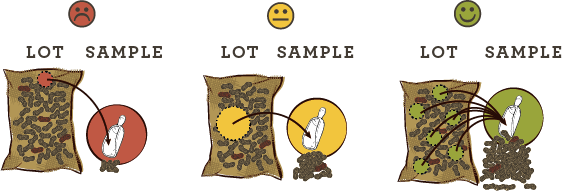
Of the three steps, sampling is the most complex, but also the most important. Retrieving a representative sample from the lot – a sample that represents the overall conditions throughout the lot – is key to getting an accurate measure of aflatoxin contamination.
A. flavus, the mold that produces aflatoxin can infect a single kernel of groundnut or maize, making that one “hot” kernel important to capture in any sampling process. Since the testing process destroys the sample, the person conducting the test doesn’t want to draw too large a sample (and sacrifice too much crop), but also doesn’t want to capture a disproportionate number of infected kernels. This could make the larger lot seem more contaminated than it is and lead the owner to destroy it.
Sampling protocols help to achieve the most accurate test result from large lots to balance the risks to both consumers and producers who may have product unnecessarily rejected.
Since aflatoxin may appear erratically across a lot, small mini-samples should be taken randomly from throughout the lot and combined to create a sample that represents conditions throughout the lot.

